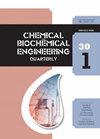一种新型苯酚降解菌株的分离、动力学和性能研究
IF 0.9
4区 生物学
Q4 BIOTECHNOLOGY & APPLIED MICROBIOLOGY
引用次数: 1
摘要
高效的酚降解菌仍然是生物处理含酚废水的关键。本研究分离到了一株新的酚降解菌N8。经16S rDNA鉴定,N8菌株为芽孢杆菌sp. IARI-J-20。废水处理实验表明,在接种量为15%、温度为30℃、pH为7.2、酵母浸膏添加量为0.08%、苯酚初始浓度为225 mg L-1的条件下,24 h N8的苯酚降解率可达92.8%。Haldane模型适用于苯酚降解菌株N8在苯酚初始浓度50 ~ 1200 mg L-1范围内的生长动力学,其动力学值μmax = 0.33 h−1,Ks = 79.16 mg L-1, Ki = 122 mg L-1。苯酚浓度为400 mg L-1时,产率系数达到最大值。当苯酚初始浓度大于400 mg L-1时,苯酚的抑制作用起主导作用。本文章由计算机程序翻译,如有差异,请以英文原文为准。
Isolation, Kinetics, and Performance of a Novel Phenol Degrading Strain
Efficient phenol-degrading bacteria is still the key to the biological treatment of phenol-containing wastewater. In this research, a novel phenol-degrading strain N8 was isolated. According to the 16S rDNA identification, it was concluded that the N8 strain was Bacillus sp. IARI-J-20. The wastewater treatment experiments showed that the phenol degrading rate of N8 reached 92.8 % at 24 h with the inoculation amount of 15 %, temperature of 30 °C, pH of 7.2, yeast extract addition of 0.08 %, and initial phenol concentration of 225 mg L–1. Haldane’s model was fit for the growth kinetics of the phenol-degrading strain N8 over a wide range of initial phenol concentrations (50–1200 mg L–1), with kinetic values μmax = 0.33 h−1, Ks = 79.16 mg L–1, and Ki = 122 mg L–1. The yield coefficient reached maximal value when the phenol concentration was 400 mg L–1. When the initial phenol concentration was more than 400 mg L–1, the inhibition effect of phenol became predominant.
求助全文
通过发布文献求助,成功后即可免费获取论文全文。
去求助
来源期刊
CiteScore
2.70
自引率
6.70%
发文量
23
审稿时长
>12 weeks
期刊介绍:
The journal provides an international forum for presentation of original papers, reviews and discussions on the latest developments in chemical and biochemical engineering. The scope of the journal is wide and no limitation except relevance to chemical and biochemical engineering is required.
The criteria for the acceptance of papers are originality, quality of work and clarity of style. All papers are subject to reviewing by at least two international experts (blind peer review).
The language of the journal is English. Final versions of the manuscripts are subject to metric (SI units and IUPAC recommendations) and English language reviewing.
Editor and Editorial board make the final decision about acceptance of a manuscript.
Page charges are excluded.

 求助内容:
求助内容: 应助结果提醒方式:
应助结果提醒方式:


